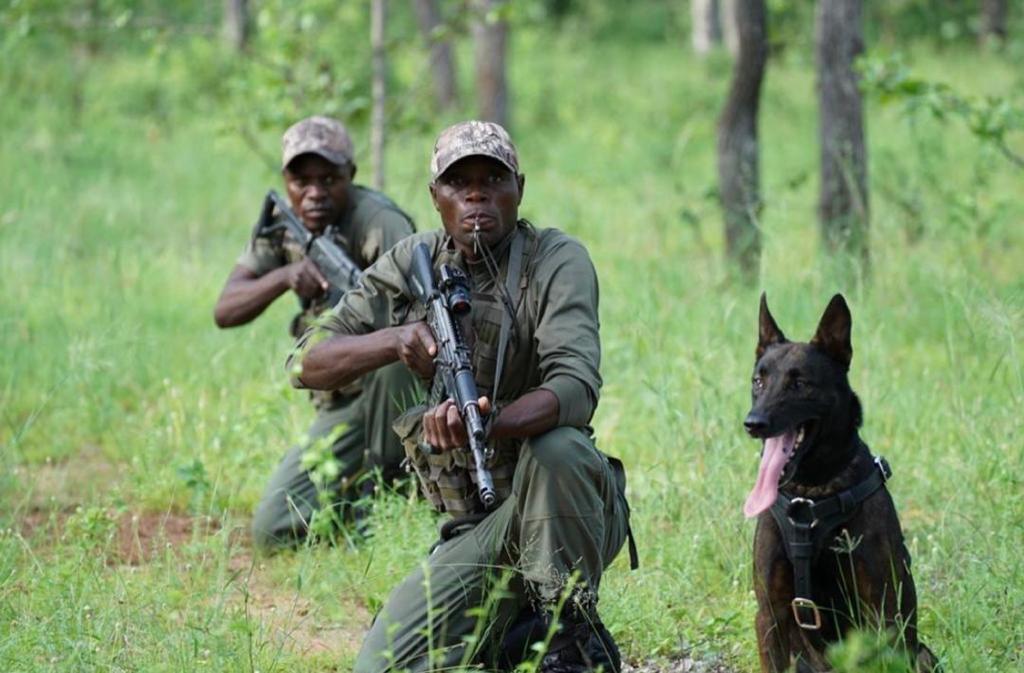Poachers jailed for 189 years thanks to specialist wildlife dog unit in Zimbabwe
Dog team brought in for 3-month trial 10 years ago remains today, helping rhino numbers grow despite global poaching surge

By Farayi Machamire for Zim Morning Post
Mathius Mbengo’s day begins at 3am, breaking sleep to hop onto a truck for inspections around the Savé Valley Conservancy in south eastern Zimbabwe.
By 5am, Mathius is on foot with his K9 unit partner, traversing the conservancy on spoor detections.
On detection tracks, Mathius and his Belgian Malinois partner can run up to 25 kilometres. It’s an active 24-hour cycle and the 44-year-old Mathius and his partner work tirelessly.
All hands on deck by rangers, K9s and conservation players is the reason why the Anti-Poaching Tracking Specialists (ATS) team reached significant milestones in April 2022, marking a decade of monitoring and protecting Zimbabwe’s black and white rhino population in the Savé Valley Conservancy.
In 10 years of creating an environment for rhinos to thrive, the ATS K9 unit has dismantled dozens of notorious rhino poaching syndicates, accumulating 189 years in prison sentencing.
In the last four years, operations by ATS led to the arrest of 29 rhino poachers, while the lead K9 and his handler, tracked down and apprehended four different rhino poaching gangs, a significant achievement on the front lines of anti-poaching.
The Savé Valley Conservancy is one of the largest private game reserves in Africa, covering 3,000 sq km (1,150 sq miles).
Home to protected species like elephants, pangolins, painted dogs, cheetahs, lions, sables, pythons, ground hornbills and lappet-faced vultures, the Savé Valley Conservancy holds 25 percent of Zimbabwe’s black rhino population making it a critical stronghold, of one of three Intensive Protected Areas in Zimbabwe for rhino, and one of nine in the whole of Africa.
Authorities say Zimbabwe has about 1,000 rhinos after poaching decimated populations three decades ago.
Andrew Campbell, Director of the Game Rangers Association of Africa, believes the “ATS and its K9 unit of 11 Malinois, is one of the most active, and results oriented, rhino anti-poaching organisations in Southern Africa, and certainly in Zimbabwe.”
Among various strides made by ATS is the apprehension of a poacher in the Savé Valley Conservancy through ATS detections, who was in April 2022, sentenced to nine years in prison by a Masvingo court after a full trial.
The convict, Wellington Bonga, was tracked by the K9s, and arrested in possession of a FN Shotgun rifle with modified bullets with solid heads.
Four other suspects are currently in court over poaching – arrested through ATS detections and tracked by the K9 unit.
It is these strides that Bryce Clemence, co-founder of ATS, says gives their conservation efforts merit, as they celebrate 10 years of protecting rhinos and other key species wildlife in the Conservancy.
Clemence was awarded the Best Game Ranger in Africa by the Game Rangers Association of Africa for the Rhino Conservation Awards 2021.
“The last 10 years in the Savé Valley Conservancy have been extremely challenging. Our team has faced a lot of armed poaching gangs but we are very proud to have been able to successfully grow our rhino population,” Clemence says.
Australia based NGO, Save African Rhino Foundation, which has been working in Zimbabwe for 35 years says the ATS team has played a pivotal role in fighting wildlife crime.
“I had known of Bryce, Pete and the Clemence family, from their work as a training organisation to support Zimbabwe Parks with rangers for wildlife areas. In 2009, there was a nation-wide, rhino poaching surge, and a lack of facilities to support this,” says Nicholas Duncan, the President and co-Founder of Save African Rhino Foundation.
“In particular, the Savé Valley Conservancy in the south of the country, was under immense rhino poaching pressure, and this went on for some time. In 2012, we brought ATS into the region for a three month assessment of the situation, to try to put some systems in place and. find the gaps, and the team has been on the ground, holding the security ever since,” Duncan adds.
Under the protection of ATS, the rhino population in SVC has seen a biological growth rate of 7%, this is above the 5% IUCN recommendation for game reserves protecting rhino, and maintained a poaching mortality rate of below 2%, also recommended by the IUCN.
This has seen to fruition, the overriding goal underpinning all activity of ATS, the translocation of four black rhino, including two pregnant mothers, to Gonarezhou National Park in July 2021: a regeneration program deemed a monumental success for conservation in Zimbabwe.
“ATS has cultivated a very strong intelligence network within the communities. This has contributed to at least 80% of anti-poaching successes,” says Clemence.
While arrests and convictions are celebrated, cases of poaching remain, targeted under the belief that they treat medicinal issues, from cancer to clearing toxins and curing hangovers.
In February 2022, a pregnant white rhino cow was poached and killed for its horn in the Savé Valley Conservancy. Along with South Africa, Namibia and Kenya, Zimbabwe remains an important frontier for conserving the critically endangered species.
This article is reproduced here as part of the African Conservation Journalism Programme, funded in Angola, Botswana, Mozambique, and Zimbabwe by USAID’s VukaNow: Activity. Implemented by the international conservation organisation Space for Giants, it aims to expand the reach of conservation and environmental journalism in Africa, and bring more African voices into the international conservation debate. Read the original story here:
Join our commenting forum
Join thought-provoking conversations, follow other Independent readers and see their replies
Comments
Bookmark popover
Removed from bookmarks